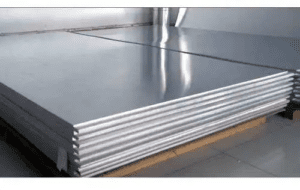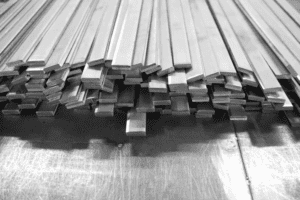Aluminum is widely valued for its lightweight, corrosion resistance, and versatility across numerous industries.
One of the most crucial factors fabricators must understand is the aluminum melting point, which significantly impacts the casting, welding, and forming processes.
This article offers an in-depth look at aluminum’s melting point, comparing it to other metals and exploring how factors like alloys, impurities, and temperature control influence its behavior during fabrication.
How Aluminum’s Melting Point Stacks Up Against Other Metals
| New Aluminum Cast Plate | New Aluminum Sheet | Verified Remnant Aluminum Plate |
 |
 |
 |
| – Alloys Available: 5080 Alimex and 5083 ALCA 5 – Superior precision for demanding applications – Corrosion-resistant and wear-resistant surface – Customizable sizes for versatile use |
– Alloys Available: 6061 – Versatile for automotive, construction, and furniture – Custom sizing available for precision needs – Lightweight yet durable material for diverse applications |
– Alloys Available: 6061 and 7075 – Versatile for multiple applications – Precise cut tolerance for custom needs – Durable material suitable for various industries |
The melting point of aluminum is 660°C (1220°F), which is a relatively low melting point compared to many industrial metals. This makes it more energy–efficient for melting and casting.
Steel vs. Aluminum: A Higher Heat Requirement
In contrast, steel, particularly carbon steel, has a much higher melting point, ranging from 1425°C–1540°C (2597°F–2800°F), requiring more energy for processing.
Copper: A Mid-Range Melting Point
Copper has a melting point of 1084°C (1983°F), higher than aluminum but lower than steel, striking a balance between thermal conductivity and energy efficiency.
Aluminum’s Behavior in Thermal Processes
The lower melting point of aluminum also affects its welding techniques, requiring careful heat control to prevent warping and defects during thermal processes.
| Fact: In the late 1960s, scientists suspected a link between aluminum and Alzheimer’s disease, claiming to have found it in the brains of affected individuals. However, by the 1990s, more advanced studies disproved this, and aluminum hasn’t since been found to be a direct cause of Alzheimer’s disease. |
What Factors Can Affect the Melting Point of Aluminum?
The melting point of aluminum, which is approximately 660°C (1220°F), can be influenced by several factors. These factors include temperature and pressure conditions, the presence of other elements, and the purity of the aluminum.
The production process to melt aluminum can be optimized by carefully managing these factors.
Temperature and Pressure
The melting point of aluminum can vary slightly with changes in temperature and pressure. Under standard atmospheric pressure, aluminum melts at its typical melting point temperature.
However, under high-pressure conditions, the melting point can increase.
Conversely, in a vacuum or low-pressure environment, the melting point may decrease. These variations are generally minor but can be significant in specialized industrial processes.
Presence of Other Elements
The introduction of other alloying elements into aluminum can significantly alter its melting point. This is particularly relevant in the context of aluminum alloys, where elements such as copper, magnesium, silicon, and zinc are added to enhance specific properties.
For example, adding copper to aluminum can lower the melting point, making the alloy easier to cast.
Magnesium can increase the melting point, providing better performance at higher temperatures.
Silicon can lower the melting point and improve fluidity, which is beneficial for casting processes.
Zinc can also lower the melting point and is often used in die-casting alloys.
Purity of Aluminum
The purity of aluminum is a critical factor in determining its melting point.
Pure aluminum has a consistent melting point of 660°C. However, commercial-grade aluminum often contains impurities that can affect this temperature.
Common impurities include iron, silicon, and other trace elements. The presence of these impurities can lower the melting point and alter the melting behavior of the aluminum.
For instance, high-purity aluminum (99.99% pure) will have a more precise and higher melting point compared to lower-purity grades.
Can Aluminum Alloys Have Different Melting Points?
| Verified Remnant Aluminum Rectangular Bar | New Aluminum Flat Bar |
 |
 |
| – Alloys Available: 6061 – High-quality aluminum remnants ideal for various applications – Excellent machinability and strength – Lightweight yet durable for versatile use |
– Alloys Available: 6061 – Versatile for framing, support, and manufacturing – Custom sizes available for precision projects – Durable and easy to manipulate for fabrication |
Aluminum extrusions can take advantage of alloys with different melting points, depending on their specific applications. Recycled aluminum can also be used in the production process to reduce energy consumption.
Aluminum alloys can indeed have different melting points, which vary based on their specific compositions.
The addition of other elements to aluminum creates alloys that can exhibit a wide range of melting temperatures.
These variations are crucial for different industrial applications, as they allow for the selection of an alloy that best suits the thermal and mechanical requirements of a given process.
The melting point of an aluminum alloy is influenced by the type and proportion of alloying elements. Common alloying elements include copper, magnesium, silicon, zinc, and manganese.
Each of these elements affects the melting point in distinct ways. For instance, adding copper to aluminum typically lowers the melting point. For example, the aluminum-copper alloy 2024 has a melting range of approximately 502°C–638°C (935°F–1180°F).
Magnesium can affect the melting point of aluminum alloys, but not as significantly as copper, which tends to have a more substantial lowering effect. The aluminum-magnesium alloy 5052 has a melting range between approximately 607°C and 649°C (1125°F–1200°F).
Silicon is often added to improve castability and reduce melting temperature. The aluminum-silicon alloy 4047 has a melting range of approximately 577°C–582°C (1071°F–1079°F).
When added to aluminum, zinc moderately lowers the melting point. The aluminum-zinc alloy 7075 has a melting range between 477°C and 635°C (891°F–1175°F).
Manganese has a less pronounced effect on the melting point of aluminum compared to other alloying elements but can contribute to some melting point depression. The aluminum-manganese alloy 3003 has a melting range of approximately 643°C–654°C (1190°F–1209°F).
| Did You Know? Hans Christian Ørsted was the first to isolate aluminum in 1825 in Copenhagen, Denmark. He accomplished this by reducing aluminum chloride with potassium amalgam, though the aluminum he produced was impure. At the time, aluminum was incredibly costly due to the difficulty in isolating it, and by the 1860s, Emperor Napoleon III of France had made a set of aluminum cutlery and dishes to impress important guests, as aluminum was considered more precious than gold. |
How Can Impurities in Aluminum Affect Its Melting Point?
Impurities in aluminum can significantly influence its melting point, often leading to variations that can impact the material’s performance in various applications.
The presence of impurities can either raise or lower the melting point, depending on the type and concentration of the impurity.
Iron (Fe)
Iron is one of the most common impurities in aluminum. Even small amounts of iron can lower the melting point of aluminum. This is because iron forms intermetallic compounds with aluminum, which have different melting points compared to pure aluminum.
Silicon (Si)
Silicon is often added to aluminum to improve its casting properties.
However, as an impurity, silicon can lower the melting point of aluminum. The formation of aluminum-silicon eutectic mixtures can result in a melting point that is significantly lower than that of pure aluminum.
Copper (Cu)
Copper is another impurity that can affect the melting point of aluminum.
The presence of copper can lower the melting point, as copper-aluminum alloys have lower melting points than pure aluminum. This is particularly relevant in the production process of aluminum alloys, where controlled amounts of copper are added to achieve desired properties.
Magnesium (Mg)
Magnesium can either raise or lower the melting point of aluminum, depending on its concentration.
At low concentrations, magnesium tends to lower the melting point, while at higher concentrations, it can raise the melting point due to the formation of magnesium-aluminum intermetallic compounds.
Zinc (Zn)
Zinc, when present as an impurity, generally lowers the melting point of aluminum. This is due to the formation of aluminum-zinc alloys, which have lower melting points compared to pure aluminum.
| Energy Saver Insight: Recycled aluminum scrap conserves more than 90% of the energy needed to extract aluminum from bauxite. |
Methods of Reducing Impurities on Aluminum’s Melting Point
To mitigate the effects of impurities on the melting point of aluminum, several methods are employed:
Refining
The refining process involves removing impurities from aluminum to achieve a higher purity level. This can be done through techniques such as fractional crystallization and zone refining.
In contrast, melting point depression (a lower melting point) is generally achieved by adding alloying elements such as copper or magnesium rather than through refining.
Alloying
Controlled addition of certain elements can help counteract the effects of impurities. For example, adding small amounts of titanium or boron can help neutralize the impact of iron impurities by refining the grain structure and preventing brittle Fe-Al compounds.
While this improves the overall properties of the aluminum, melting point depression is usually achieved by other alloying elements, such as copper or silicon, which lower the alloy’s melting point and are critical in the selection of the right aluminum alloy for specific applications.
Filtration
During the liquid phase of the process to melt aluminum, filtration can be used to remove solid impurities from the molten aluminum.
Ceramic foam filters are commonly used for this purpose.
What Are the Best Practices for Melting Aluminum in a Fabrication Setting?
| Verified Remnant Aluminum Square Tubing | New Aluminum Round Tubing |
 |
 |
| – Alloys Available: 6061 and 6063 – Lightweight and high-strength tubing – Ideal for structural and decorative uses – Sustainable option by reducing material waste |
– High strength and corrosion resistance – Lightweight, ideal for aerospace and automotive – Custom cuts and anodized finishes available – Versatile for structural and decorative projects |
Melting aluminum in a fabrication setting requires adherence to specific best practices to ensure efficiency, safety, and quality. These practices encompass temperature control, preparation of materials, and operational procedures.
Temperature Control Techniques
Utilize thermocouples and infrared thermometers to continuously monitor the temperature of the aluminum.
Maintaining a consistent temperature is crucial to prevent overheating, which can lead to oxidation and contamination of the molten metal.
Gradually increase the temperature to avoid thermal shock, which can cause cracking or other structural issues in the aluminum.
Aim to reach and maintain the optimal melting temperature of pure aluminum, which is approximately 660°C (1220°F). For aluminum alloys, the melting range depends on their specific composition. Maintaining the correct melting temperature ensures that the aluminum melts uniformly without degrading its properties, preventing issues such as oxidation or contamination.
Preparation of Aluminum
Thoroughly clean the aluminum to remove any surface contaminants such as oils, dirt, or oxides. This can be achieved through mechanical cleaning methods like wire brushing or chemical cleaning using solvents.
Preheat the aluminum to a temperature just below its melting point. This step helps reduce thermal stress and ensures a more uniform melting process.
If melting aluminum alloys, segregate different types to prevent cross-contamination. Each alloy has a specific melting range, and mixing them can result in inconsistent melting and inferior quality.
Operational Procedures
Choose the appropriate type of furnace for the melt aluminum process. Common options include induction furnaces, which offer precise temperature control, and gas-fired furnaces, which are cost-effective for large-scale operations.
Use fluxes to remove impurities and oxides from the molten aluminum. Fluxing agents help to produce cleaner metal and reduce the formation of dross.
Implement degassing techniques to remove hydrogen and other gases dissolved in the molten aluminum. This can be done using rotary degassing equipment or by introducing inert gases like argon or nitrogen.
When pouring molten aluminum into molds, ensure a steady and controlled flow to minimize turbulence and the introduction of air bubbles. Ladles or automated pouring systems designed for aluminum are used to achieve this.
Common Mistakes to Avoid
Avoid exceeding the melting temperature significantly, as this can lead to excessive oxidation and loss of material properties.
Failing to properly clean the aluminum before melting can result in contamination and defects in the final product.
Mixing different aluminum alloys without proper segregation can lead to unpredictable melting behavior and compromised material quality.
| Highlight: Aluminum is the third most abundant element in the Earth’s crust, making up around 8.1% of its total weight. |
Master the Aluminum Melting Process
Implement these best practices for efficient aluminum melting to master the aluminum extrusions and production process. These strategies ensure the highest quality results, from controlling temperature to selecting the right alloys. Understanding the unique properties of aluminum, including its melting point, will help fabricators make informed decisions for their applications, ensuring both safety and efficiency.
 Angle
Angle Cast Plate
Cast Plate Diamond Plate
Diamond Plate Flat Bar
Flat Bar Plate
Plate Round Bar
Round Bar Square Bar
Square Bar Square Tubing
Square Tubing Round Tubing
Round Tubing Angle
Angle Channel
Channel Diamond Plate
Diamond Plate I Beam
I Beam Round Bar
Round Bar Sheet
Sheet Square tubing
Square tubing Round Tubing
Round Tubing Rectangular Tubing
Rectangular Tubing Plate
Plate Rectangular Bar
Rectangular Bar Rectangular Tubing
Rectangular Tubing Round Bar
Round Bar Sheet
Sheet Square Bar
Square Bar Square Tubing
Square Tubing
